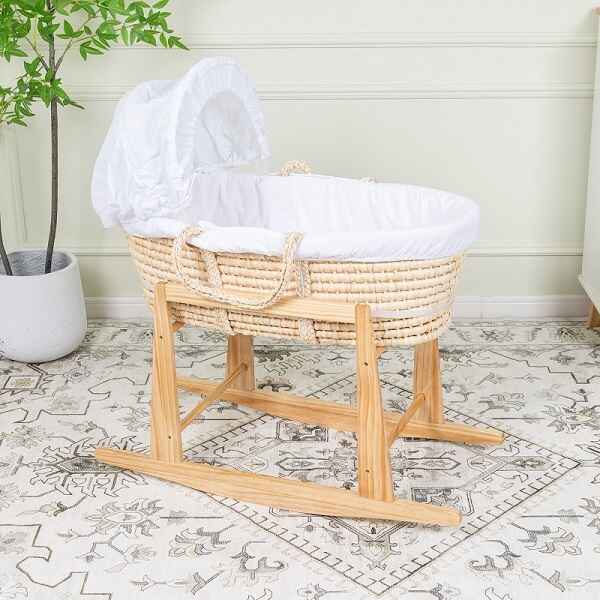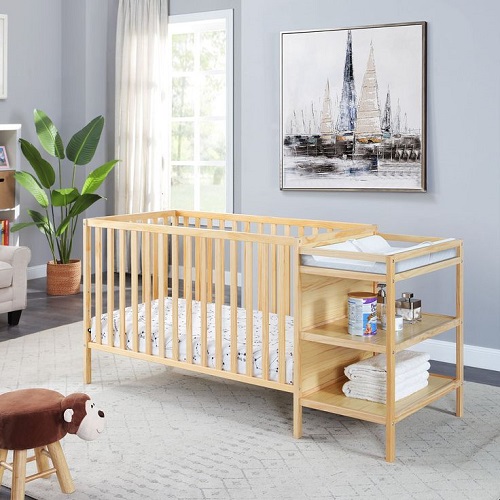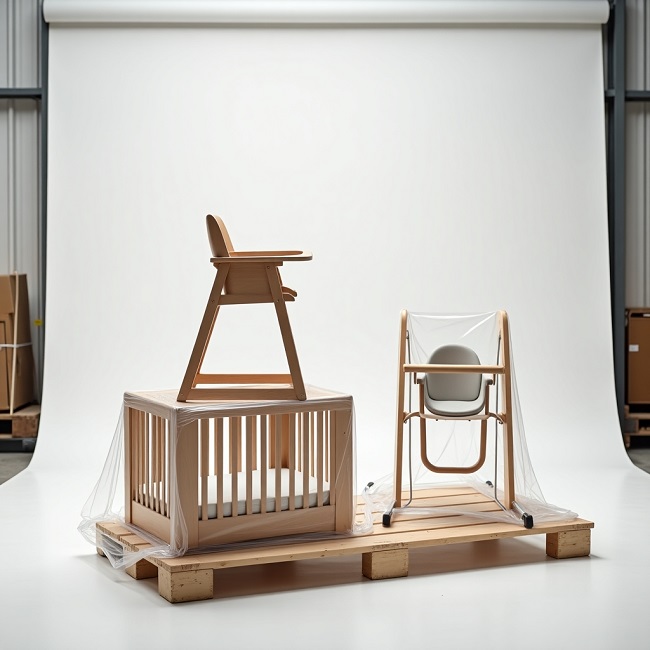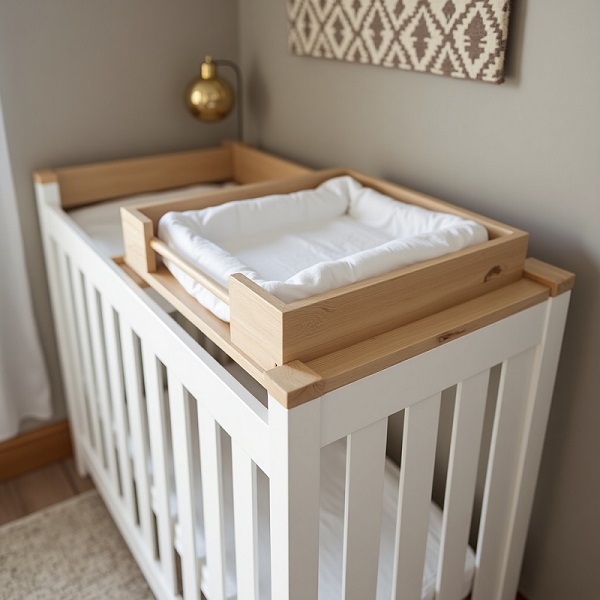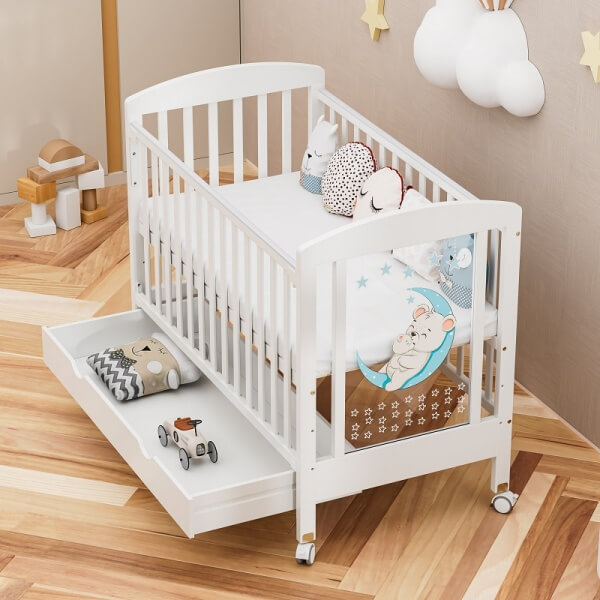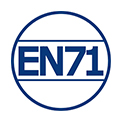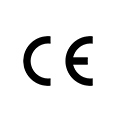As a new parent, you’ll inevitably feel overwhelmed by the bewildering array of baby products on the market. Every item seems to promise it will “help your baby sleep better,” but which ones are truly suitable for newborns? Amidst the sea of cribs, bassinets, and rocking chairs, a seemingly simple sleep solution has quietly made a comeback in recent years: the Moses basket.
This woven cradle, with biblical origins, has been reimagined by modern parents for a new purpose. Unlike bulky cribs that dominate nursery spaces or high-tech gadgets with complicated features, the Moses basket thrives on simplicity. Its lightweight, portable design has turned it into an unsung hero for families navigating the early stages of parenthood.
In this article, we’ll explore the pros and cons of Moses baskets, share practical usage tips grounded in science-backed parenting, and highlight often-overlooked details informed by real-world experience.
What Is a Moses Basket? Definition and Purpose
The concept of the Moses basket echoes across cultures throughout history—from the reed baskets of ancient Egypt to the rattan cradles of China. For millennia, humans have crafted these natural-material “mobile nests” to cradle their youngest.
The modern Moses basket is defined as a portable sleeping unit measuring approximately 27–35 inches in length and 15 inches in width. It typically features curved handles or brackets and includes a removable mattress.
Though its name derives from the biblical story of Moses being sheltered in a papyrus basket, today’s version transcends religious symbolism. It has evolved into a practical tool aligned with evidence-based parenting principles.
What sets the Moses basket apart from standard cribs is its balance of containment and mobility. Newborns sleep 16-20 hours daily but in short, fragile cycles. The basket’s compact design mirrors a baby’s natural curled posture (the medically recognized fetal position), while its slightly yielding walls help dampen the startle reflex that disrupts sleep.
A study on premature infants revealed that boundary-mimicking environments, like those provided by Moses baskets, can lower stress hormone levels. However, researchers caution that usage must align with a child’s developmental stage.
Three Practical Roles in Modern Parenting:
- Multi-Room Sleep Station: Positioned on living room floors or study corners, it allows supervised daytime naps.
- Nighttime Care Hub: Placed bedside for safe nighttime feedings and comfort, reducing co-sleeping risks.
- Travel Sanctuary: Offers a familiar sleep environment during short trips or family visits.
Modern Moses baskets must comply with infant sleep safety regulations. Key features like mesh ventilation panels, slip-resistant bases, and controlled handle ergonomics reflect standards set by bodies like the U.S. Consumer Product Safety Commission (CPSC).
A critical design element is the 5-degree sway limit when gently rocked. Unlike the vigorous motion of some bassinets, this subtle movement suits infants under 4 months whose neck muscles are still developing.
Benefits of Using a Moses Basket for Your Baby
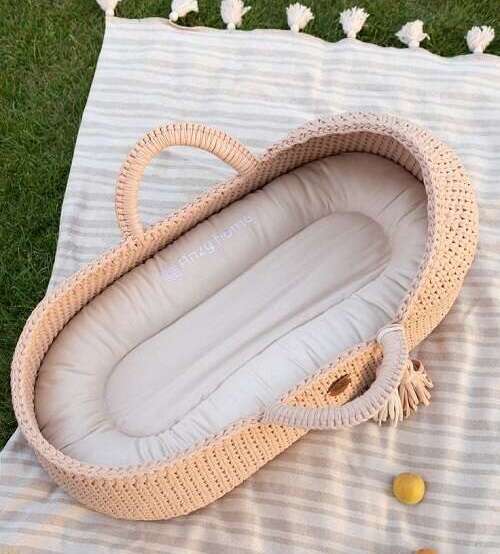
Effortless Portability
The true value of a Moses basket shines in moments like 3 AM when a newborn stirs awake in the living room. Instead of disturbing the baby, parents can silently lift the entire sleep pod and relocate it to the bedroom.
Its lightweight structure (typically under 9lbs) also simplifies nighttime care: after breastfeeding, you can gently place your baby back into the basket without leaving your bed. This mobility isn’t just convenient—it reduces disruptions for both parent and child.
Womb-Like Security
With its softly contoured walls, the Moses basket mimics the womb’s cozy enclosure—providing essential comfort during the ‘fourth trimester,’ when newborns are adjusting to life outside the womb.
A 2020 Cambridge University Infant Sleep Lab study observed that babies in environments with light lateral resistance (like Moses baskets) fell asleep 23% faster. Researchers linked this effect to the gentle pressure of the basket’s walls, which simulate the comforting sensation of amniotic fluid.
Seamless Supervision
The basket’s portability transforms parenting logistics. Picture a baby napping sunlit on the balcony—the basket allows a parent to effortlessly move both child and sleeping space to the kitchen island while preparing dinner. This “sleep-and-go” flexibility is invaluable during the phase of frequent newborn naps.
Enhanced Safety Features
From a safety standpoint, the Moses basket’s low profile helps minimize the risk of falls. When placed on an adult mattress or sofa, its edge height is usually flush with these surfaces, avoiding the “deep well effect” caused by the high fence of traditional cribs.
Studies have shown that 30% of parents will unconsciously carry crying babies to the big bed when they are extremely sleepy. As an intermediate transition product, the Moses basket can reduce the probability of accidental co-sleeping.
How Long Can the Baby Sleep in a Moses Basket?
The Moses basket’s “golden period” typically spans from birth to 4 months of age, but determining the exact time frame is less about rigid rules and more an evolving equation—one that balances weight gain, sleep patterns, and developmental milestones.
Weight Limits
Weight is the primary threshold. According to the International Infant and Toddler Sleep Safety Guidelines, when the baby weighs more than 9 kg (equivalent to the average level of 4-5 months old), the load-bearing structure and internal space of the Moses basket may no longer be safe.
However, in reality, more attention should be paid to details: when the baby’s knees begin to frequently hit the side wall when lying flat, or the shoulders touch the handle bracket when turning over, even if the weight limit is not reached, the sleeping environment should be changed in time.
Sleep Cycle Evolution
In the newborn stage (0-3 months), the baby usually sleeps for 2-4 hours each time, which perfectly matches the original design of the Moses basket short light sleep period does not require a large sleeping space.
But when the baby gradually forms a circadian rhythm after 4 months, the continuous sleep time may be extended to 5 to 6 hours, and a more stable crib is needed to support deep sleep.
The British Sleep Foundation recommends that if your baby starts to have frequent sleep interruptions in the Moses basket (such as waking up once an hour), it may be a sign that space restrictions are affecting sleep quality.
Motor Development Milestones
The most important thing to ignore is the motor development milestone. If your baby has any of the following conditions, please stop using the Moses basket immediately:
Can turn from supine to prone independently (usually occurs at 3-4 months)
Elbows support the upper body by more than 45 degrees
The feet continue to push against the side wall causing the basket to move
Can a Baby Sleep in a Moses Basket Overnight?
Theoretically, the Moses basket can support the baby’s night sleep. The American Academy of Pediatrics (AAP) confirms that certified Moses baskets can be used for overnight sleep, provided they’re placed on a firm, flat surface (e.g., the floor) and never propped on adult beds or soft furnishings.
Babies from birth to 3 months have a small stomach capacity and need to be breastfed every 2-3 hours, which happens to fit the use scenario of the Moses basket: placing the basket next to the big bed at night can not only respond to needs in time but also maintain the safety of an independent sleeping space.
The real challenge appears when the baby is about 4 months old. When the circadian rhythm gradually forms, continuous sleep may be extended to 4-5 hours, and the limitations of the Moses basket begin to appear. Its lightweight structure has weak stability when dealing with actions such as turning over and kicking. Active babies push the basket and hit the wall in their sleep, causing awakening.
More importantly, the baby’s perception of space decreases during deep sleep. If the head accidentally hits the curved side wall, it may cause risks due to insufficient breathing space.
If you decide to let your baby spend the night in a Moses basket, please remember these three “night protection rules”:
1. Be as careful as placing antique porcelain: remove all soft objects around and make sure the basket is more than 8 inches away from the wall and furniture
2. Become a temperature detective: Because the Moses basket is more ventilated than a traditional crib, you need to pay extra attention to room temperature changes and can use a wearable sleeping bag instead of a blanket
3. Set a “graduation alarm”: When the baby sleeps for more than 4 hours at night or shows signs of turning over, it is time to move to the crib
Moses Basket Vs. Bassinet: What’s the Difference?
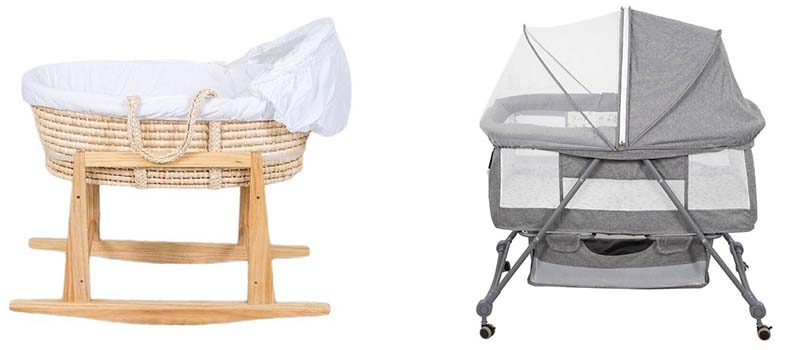
| Comparison Dimensions | Moses Basket | Bassinet |
| Design Structure | Shallow basket with handle requires floor or bracket support | With a built-in curved base or hanging structure, independent and stable |
| Safety Standards | Focus on tilt stability (10-degree slope test) | Limit the swing amplitude (anti-shake syndrome risk) |
| Usage Scenarios | Flexible placement on different planes (floor, sofa, bracket, etc.) | Fixed position use (bedroom, baby room) |
| Applicable Age | 0-4 months (or weight ≤ 9 kg) | 0-6 months (some adjustable models extend to 8 months) |
| Weight | About 2-4 kg (without stand) | About 8-15 kg (with base/drive unit) |
| Additional Features | Breathable mesh cover, removable mattress | Music player, night light, swing speed adjustment |
| Core Advantages | Portability, spatial integration | Sleep ritual, soothing function |
The curved handle design of the Moses basket makes it a “mobile nest”, while the traditional bassinet creates regular movement through mechanical swinging. This difference extends to different parenting scenarios – the former is suitable for fragmented parenting (such as working and taking care of children), while the latter is more suitable for establishing a fixed sleeping ritual.
Interestingly, anthropological research shows that the prototype of the Moses basket is common among nomadic peoples, while bassinets mostly appear in settled civilizations. This historical gene still affects the choices of modern parents: renters prefer the lightness of the Moses basket, while families with fixed residences prefer to invest in traditional bassinets.
From the perspective of usage scenarios, the Moses basket is like equipment for “sleep guerrilla warfare”:
- If the baby suddenly falls asleep while playing in the living room, you can carry it to the kitchen to continue to take care of it
- When grandparents come to help care for the baby, the basket can be temporarily set up in the study.
- Stuff it in the trunk of the car when the family travels
The traditional bassinet is more like a fortress for “sleep positional warfare”:
- Fixed in the corner of the bedroom, it helps to fall asleep through regular rocking at night
- Featuring calming extras like built-in music and gentle night lights
- The rocking speed can be adjusted to meet the needs of different months of age
The golden rule for selection is:
- If you need to push the bassinet with your feet while working overtime in the study at three o’clock in the morning, choose the Moses model.
- If you want to use regular rocking to help your baby distinguish between day and night, the traditional model is more suitable.
- A practical compromise is choosing a Moses basket stand with a rocking function—just ensure its attachment points comply with CPSC safety regulations.
Conclusion
As a newborn sleeping tool, the core value of the Moses cradle is to provide a safe and convenient transition solution for the early stage.
For parents who are considering using it, we recommend that the cradle be placed on a hard surface such as the floor at night and immediately stopped when the baby is able to turn over.
However, it is suitable for short-term care and space movement needs, and is not recommended as a long-term sleep solution. As the baby grows, a timely transition to a more stable sleeping environment is a continuous way to ensure safety and health.
Recommended Related Articles:
- Are Moses Baskets Safe? What You Need to Know
- Bassinet Vs Moses Basket: Which One Should You Choose?
- Best Bassinet for Small Spaces: A Complete Guide
- Co-Sleeper vs Bassinet: Which Is Right for Your Baby?
- What To Do If a Newborn Won’t Sleep In Their Bassinet?
- What Are the Different Types of Bassinets?

